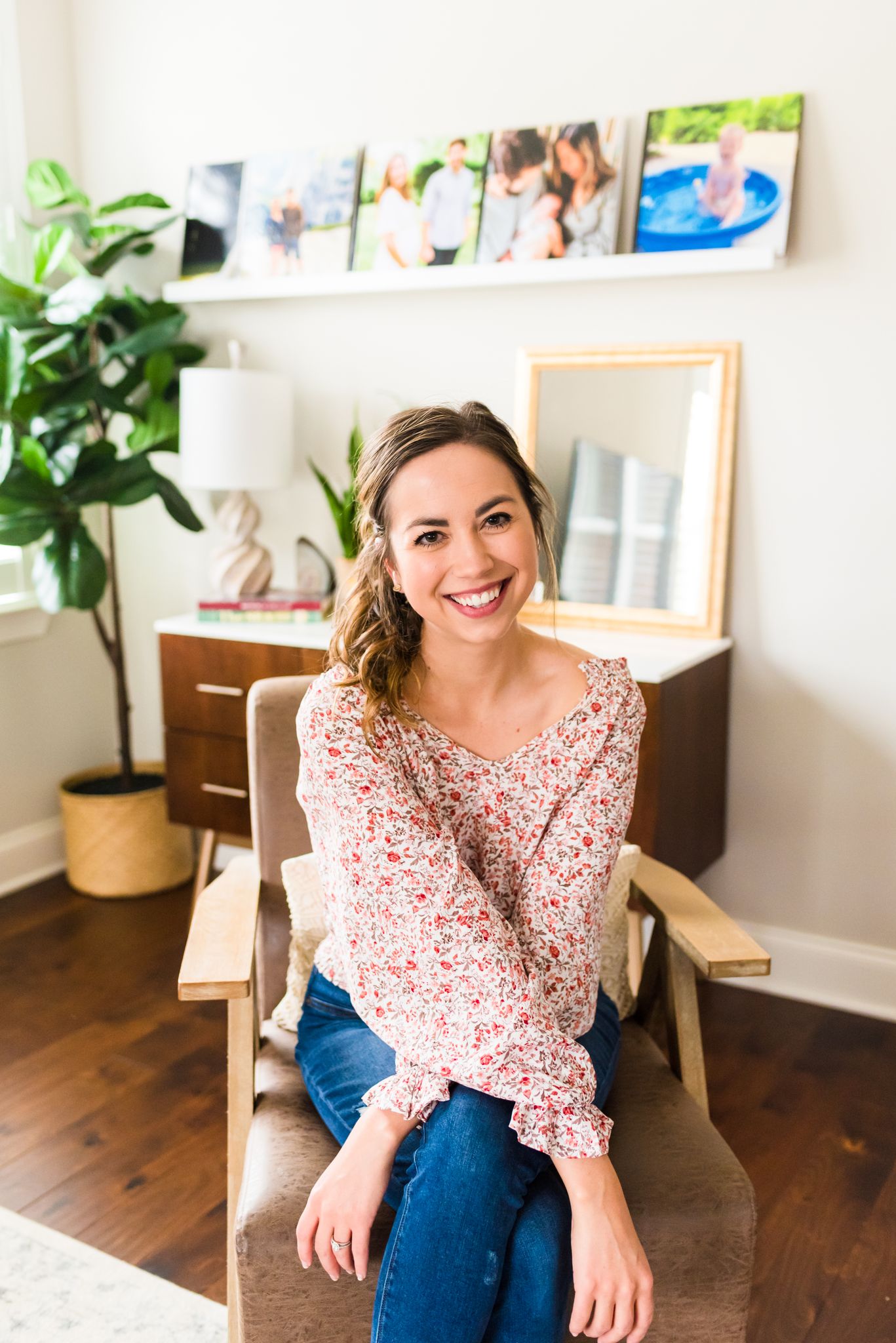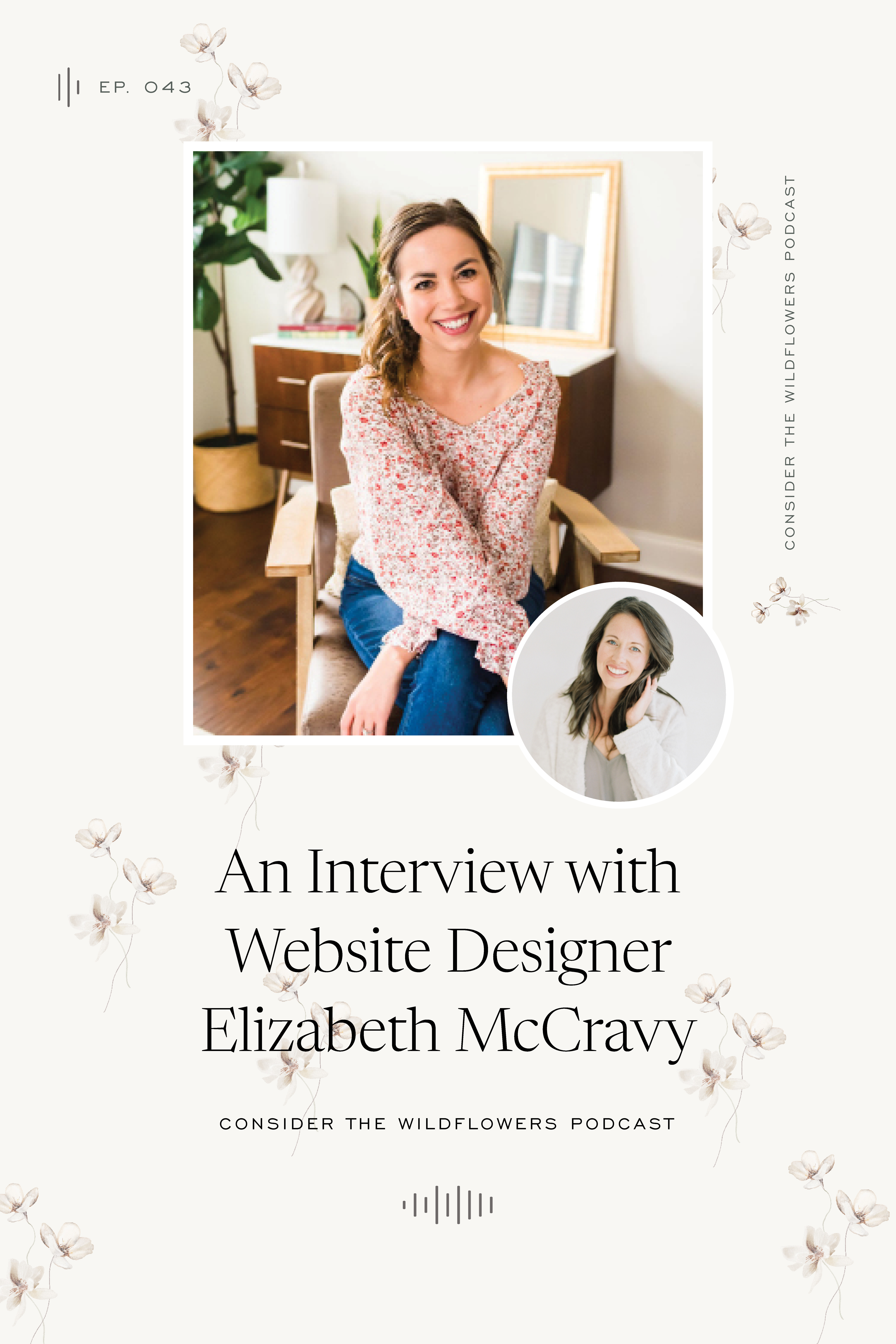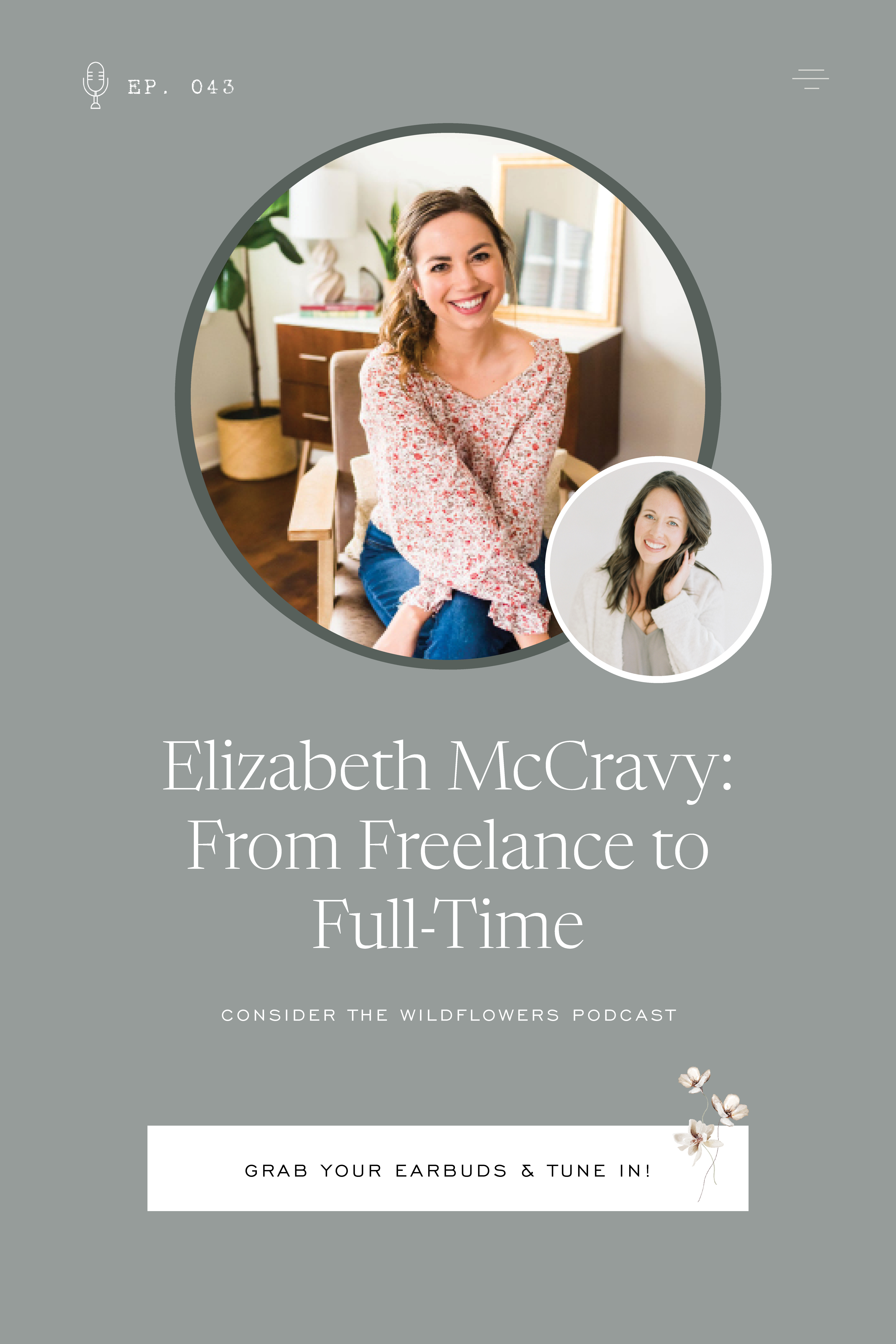Keep Reading
Elizabeth McCravy: From Freelance to Full-time
APPLE PODCASTS | SPOTIFY | STITCHER Elizabeth McCravy: From Freelance to Full-time From coding MySpace websites in middle school to launching a web design template shop post-graduation, Elizabeth McCravy has always had an entrepreneurial streak. Elizabeth is a website designer, business coach, and podcast host. In just a few short years, she was able to […]

Paragraph
APPLE PODCASTS | SPOTIFY | STITCHER
Elizabeth McCravy: From Freelance to Full-time
From coding MySpace websites in middle school to launching a web design template shop post-graduation, Elizabeth McCravy has always had an entrepreneurial streak.
Elizabeth is a website designer, business coach, and podcast host. In just a few short years, she was able to go from freelancing on the side of her nannying job to building a business that supports her family.
Now she’s sharing an inside look at that journey, the lessons learned, and what no one tells you about going full-time with your business. From launching digital products to building a $100,000 emergency fund, this is a conversation you don’t want to miss!
An Accidental Entrepreneur
Elizabeth fell into entrepreneurship somewhat reluctantly – although she always had a strong business sense. In middle school, she designed MySpace websites, bought and resold items on eBay, and even kept a business dreams journal.
By the time she reached high school, those dreams had taken a backseat to more practical concerns. Elizabeth decided to study nursing because it felt like a safer career option.
It didn’t take long to realize that wasn’t the right path for her. Her college career counselor recommended she switch majors to digital media studies with a focus on graphic design.
After graduation, Elizabeth landed a job at an advertising agency in Nashville, where she intended to stay for the foreseeable future.
Except for one small problem: she hated it.
Leaving Agency Work Behind
“My career before my business was short-lived,” Elizabeth says. From her first day at the Nashville agency, she knew it wasn’t the right fit. So she handed in her notice with the plan to rely on freelance clients until she found another agency job.
It should have been a stressful decision; Elizabeth was newly married at the time, and both she and her husband were relying on her income while he finished his studies.
But Elizabeth knew she made the right decision. “I just felt such peace, like it was all going to work out.” And it did – although not the way she planned.
Transitioning from Full-time to Freelance
“I very quickly went into job application mode, looking at all the job boards for similar work in Nashville.” She applied to advertising agencies, graphic design studios, and PR firms, but didn’t hear back from anyone.
Elizabeth had freelanced on the side throughout college, so while she waited to hear back from other agencies, she started taking on more clients. During the first seven months of freelancing, she also nannied, dog-sat, and taught yoga.
“I can’t recommend that enough for new business owners. If you’re going into an unstable field, having that extra income gives you consistency and flexibility to work on your business.”
What to Know Before Going Full-time with Your Business
For the first few years, Elizabeth did a bit of everything: branding, social media, billboards, in-person ads, copywriting, and email marketing. It took a while for her to go all-in on graphic design.
Although it’s become popular advice to “niche down” as soon as you start your business, Elizabeth is glad she took the time to explore her options.
“I think when you’re multi-passionate and have a lot of different skill sets you might truly not know what direction you want to go in your business.”
Like Elizabeth, I did everything and anything people asked me for during my first year. I learned what kind of work I enjoyed and what my clients needed the most help with.
By the time I officially launched, I knew exactly what I was going to be offering and what it should be priced at. I ended up bringing home $106,000 in profit my first year, and I’m not sure that would have been possible if I hadn’t taken that extra time to explore.
Branching into Digital Products
Once Elizabeth stopped marketing her other services and repositioned herself as a brand and web designer, her growth happened quickly.
“I got to a point where I had a lot of demand and was consistently booking clients. I was tired of referring people out, and I knew it was time to scale in some capacity.”
She considered an agency model but didn’t like the idea of being responsible for a team. Her audience had been asking for lower-cost ways to work with her, and that was when the idea for the template shop was born.
Elizabeth launched her shop in 2017 with four templates and a few video tutorials. Since then, she’s created dozens of templates, been named Showiteer of the Year, and helped over 1,200 business owners elevate their websites.
Making the Switch from Service-Based to Product-Based
Shifting from one-on-one services to templates wasn’t all smooth sailing. “I tried to pivot into digital products way too early.”
Back in 2016, Elizabeth was still figuring out brand and website design. She didn’t have an email list and wasn’t super active on social media. But she saw other people launching pre-made brands and decided to create her own.
“Looking back, I didn’t put much thought into it and no one was asking me for it. So it’s not surprising that I heard absolute crickets.”
While it was discouraging at the time, Elizabeth is grateful for that experience and the lessons it taught her.
Reframing Your Set Backs
If you’ve ever had a product launch not go as planned, Elizabeth offers a helpful reframe:
When you’re making a business decision or even a personal life decision, ask yourself the question: is there a way I can win doing this even if it fails? Could you gain a new relationship or learn something new?
In the case of Elizabeth’s pre-made brands, she learned exactly what she needed to create a wildly successful template shop years later.
Before You Create Those Digital Products…
“If you want to transition to a one-to-many model, it’s not always as simple as the gurus tell you.” Before you can sell digital products, you need to create demand and build a track record through one-on-one work.
Eventually, all that hard work will pay off and you’ll be able to create more passive revenue. For Elizabeth, that’s been a game-changer – especially since she had her son.
“I feel like it’s a completely different business in some ways. I still work with some one-on-one clients, but definitely less since becoming a mom.”
Adding a Teaching Element
Another big turning point in Elizabeth’s business was launching her podcast in 2019. “That was my first time teaching, and I truly enjoy creating content for it. It lights me up.”
Breakthrough Brand is an honest look at the lessons Elizabeth has learned in her business, what’s worked, and what hasn’t. “I show up like an open book.”
Teaching on the podcast is what ultimately led Elizabeth to create her course, Booked Out Designer.
The Importance of Having an Entrepreneurial Support System
Elizabeth wasn’t the first business owner in her family. Her father was a serial entrepreneur, and he left a lasting legacy in Elizabeth’s life.
“My father was always very encouraging that I could do whatever I wanted.” Although he never pressured Elizabeth to pursue entrepreneurship, once she started freelancing, he did urge her to own up to the title of business owner.
“He was like, ‘Hey, you have a business. You’re just not calling it a business. But you can do this.’”
In the early days, when Elizabeth was working multiple side hustles, her parents and her husband were the ones who encouraged her to keep going. Now a parent herself, Elizabeth hopes to pass on that same encouragement to her son.
Coming to Terms With Childhood Money Beliefs
Growing up, Elizabeth received mixed messages about money. On the one hand, it felt like money was scarce and there was never enough.
“It was really common growing up for us to have conversations like, ‘Our utilities might get turned off this month because we don’t have money for the bills or our phones are going to get turned off because that check might bounce.’”
Both of Elizabeth’s parents filed for bankruptcy separately. When she was in elementary school, their house was foreclosed on. “All that being said, we always had food on the table, clothes to wear, and plenty of fun activities to do.”
The message she internalized was that money was unpredictable; sometimes it was there and sometimes it wasn’t. That kind of upbringing might have led some people to seek out stability – but Elizabeth was still drawn to the path of entrepreneurship.
The $100,000 Emergency Fund
Although she had no hesitations about starting a business, Elizabeth still had some anxiety about financial security. “I’m a huge planner. So for a long time, I had a giant emergency fund for my business, in case the worst-case scenario happened.”
It’s not often I hear about business owners saving too much money in their emergency fund, but for the size of Elizabeth’s business and her expense ratio, $100,000 was probably excessive.
Eventually, her bookkeepers advised her to do something else with the money. “It’s funny because, in our personal lives, we’re actually more risk-takers with our finances.”
Elizabeth and her husband decided to start investing in real estate, and since then, she’s slowly let her emergency fund return to a more reasonable amount.
How to Manage Your Personal and Business Finances
Like most entrepreneurs, Elizabeth was forced into learning about money management when she started her business. One advantage was that she and her husband were already in the habit of bookkeeping for their personal life
“Early on, we did all of our personal finance management in a spreadsheet, inputting and categorizing every transaction. We figured it out for ourselves and it gave us extreme awareness of where our money was going.”
If you want to become more intentional about your money, check out Blueprint At Home, our personal finance course for entrepreneurs!
Managing Cash Flow in a Business
On the business side, Elizabeth diligently tracks her cash flow and disperses multi-month payment plans to make sure her family is covered during unpredictable seasons. But she no longer worries about reaching arbitrary revenue milestones.
“Something I’ve learned is that my happiness is not tied to how much money I have.” When Elizabeth first started her business, there was a trend of making “five-figure months.” That quickly grew to six-figure years, then seven-figure.
Now she sees ads for building an eight-figure business. “The hustle of how much money you could try to make never ends.”
Does More Money Really Make You Happier?
Although the amount of money you make directly impacts your standard of living, especially if you’re struggling to make ends meet, there’s a certain point where more money won’t necessarily change your life.
According to a 2010 study by Daniel Kahneman and Angus Deaton, emotional well-being rises with income up until an annual income of ∼$75,000. After that point, there’s no correlation between income and happiness.
“Acknowledging that can take the pressure off as a business owner. I’ve really grappled with, Do I want an eight-figure-a-year business? And I can tell you, I don’t. That sounds stressful.”
Instead of trying to make more money just for the sake of it, Elizabeth is focused on building a business that supports her life – especially as a new mom.
Balancing Motherhood and Entrepreneurship
“Doing motherhood and business together has been harder than I was expecting,” Elizabeth admits. As any entrepreneur mom knows, you often feel pulled in two different directions, and it can be challenging to prioritize.
One perspective that Elizabeth has held onto is that everything is a season and the seasons of her life will continue to change. “I can joyfully lean into the season that God has me in now, whatever that is, and know that I’m right where I’m supposed to be.”
For the first year of her son’s life, Elizabeth’s business took a big step back. “It was scary if I’m being completely honest.”
At the same time, she was wrestling with the feeling of being behind. “I was worried that I’d lost my spark as a business owner or that I couldn’t keep up with the trends anymore.”
Learning to Enjoy the Journey
If you’re struggling to slow down and appreciate where you are, remember that life isn’t a race. You can have big dreams but they don’t all have to happen at once.
“I’m in my business for the long haul,” Elizabeth says. “So I’ve got time. And I know that I won’t regret working less right now while my son’s young. I don’t think I’ll ever look back and be like, ‘I wish I would’ve posted more on Instagram that week.’”
Remember that every business is unique and someone else’s revenue goal doesn’t have to be yours. It’s more important to understand what you value in life, and then figure out how much it actually costs you to live those values.
Why You Should Savor the Early Stages of Business
If you’re thinking about going full-time with your business or you’ve recently taken the leap, remember to pause and appreciate where you are right now.
If Elizabeth could go back and tell herself one thing at the start of her journey, it would be: “Soak it all in, because when you’re farther along in your business, you’ll look back on these early days as the good old days and be like, oh, that was so fun. That was so wonderful.”
“Don’t rush to some point where you think everything’s better, where the grass is greener, because the joy is in the journey of building your business, all those sweet moments that are often hard, and the rollercoaster of it all.”
More from this Episode
To hear the rest of the story and what Elizabeth is up to now, press play on the player above for the full interview or click here to download the transcript.
RESOURCES MENTIONED :
Get one month free with this link for Showit Website Platform
Elizabeth’s Website Template Shop. Use code “wildflower” for 10% off your new website template!
The Truth about Income & Happiness Article
Use code “wildflower” for 10% off Elizabeth’s Landing Page Bundle
Check out Elizabeth’s Booked Out Designer Course
–

Elizabeth McCravy
Elizabeth McCravy is a website designer and business coach living in Franklin, Tennessee. She’s helped over 1,000 business owners stand out online and show off their skills through her personality-packed Showit website templates. She was named Showiteer of the Year in 2019 and was named one of the top designers on Showit in 2020.
She’s a mentor to other designers through her course and coaching program, Booked Out Designer. And, her favorite thing is probably hosting her weekly show, The Breakthrough Brand Podcast, where she shares the reality and behind-the-scenes of building a successful business. Elizabeth also does real estate investing with her husband, and they have 5 investment properties across Tennessee and Alabama.
When she’s not podcasting, coaching, or designing new templates, you’ll find her chasing around her cute toddler, deep into the latest mystery novel, or having drinks on the porch with her husband!
CONNECT WITH ELIZABETH:
SHARE THIS:
May 4, 2023
Previous Post:
Next Post:


And if you found this helpful, share with your friends!